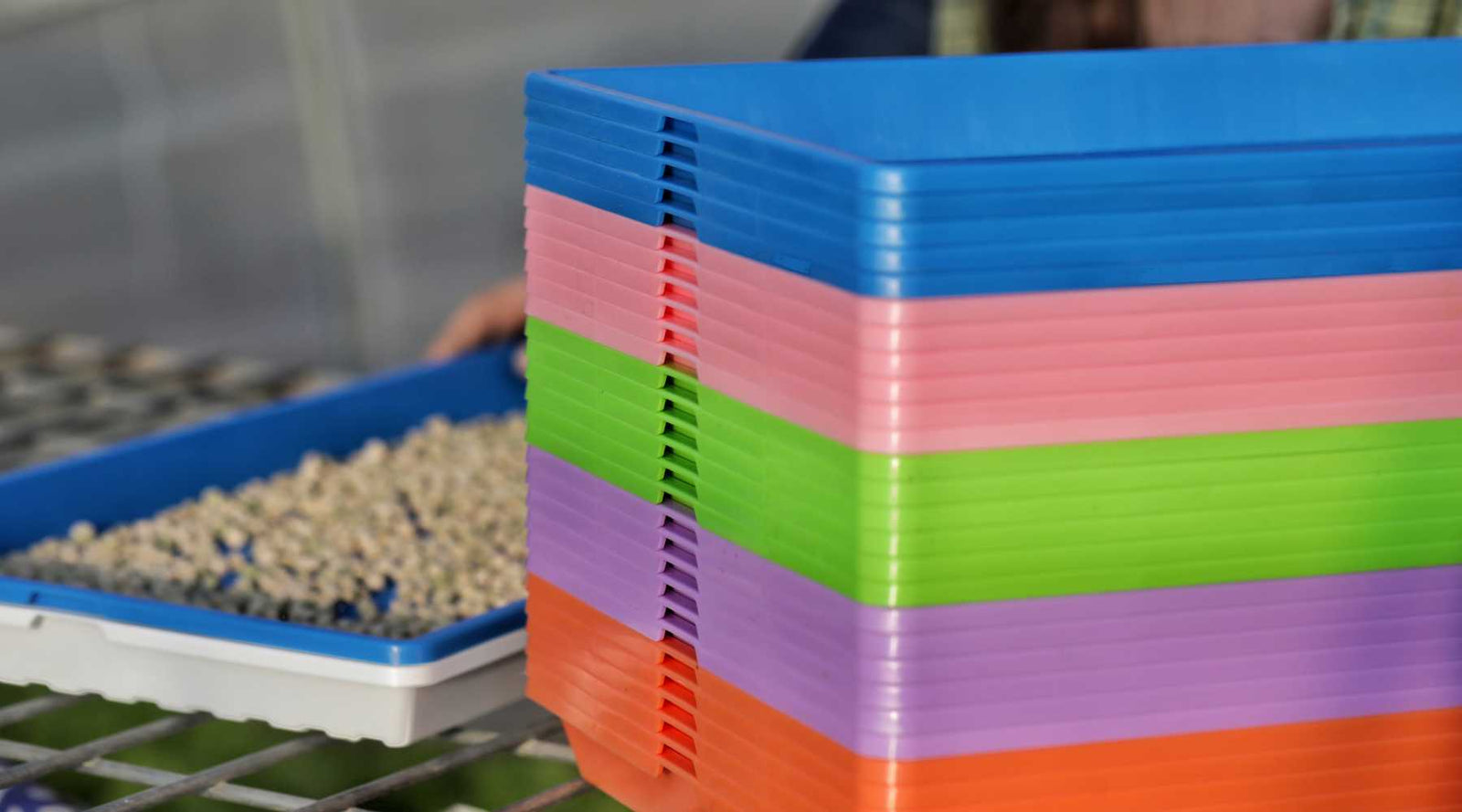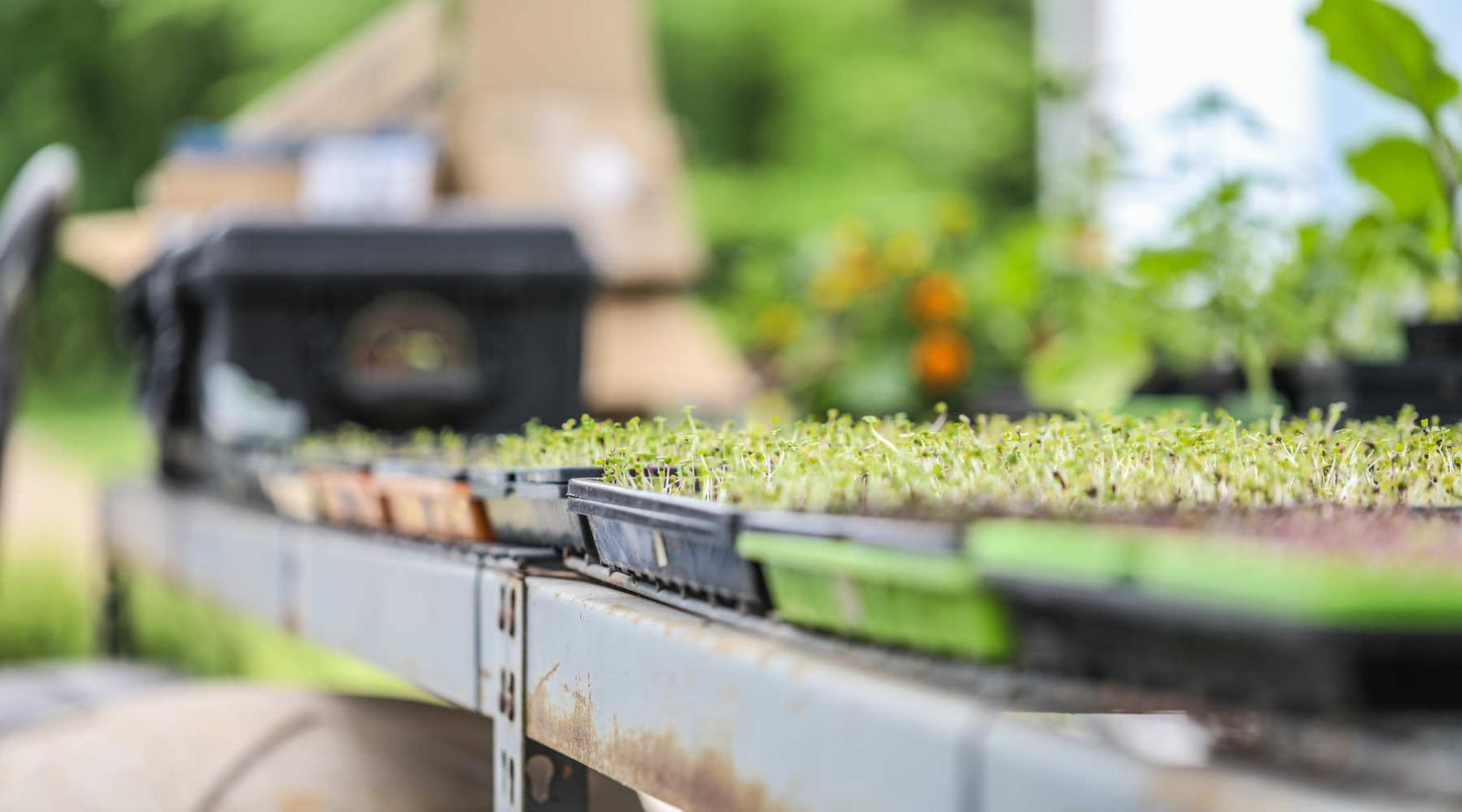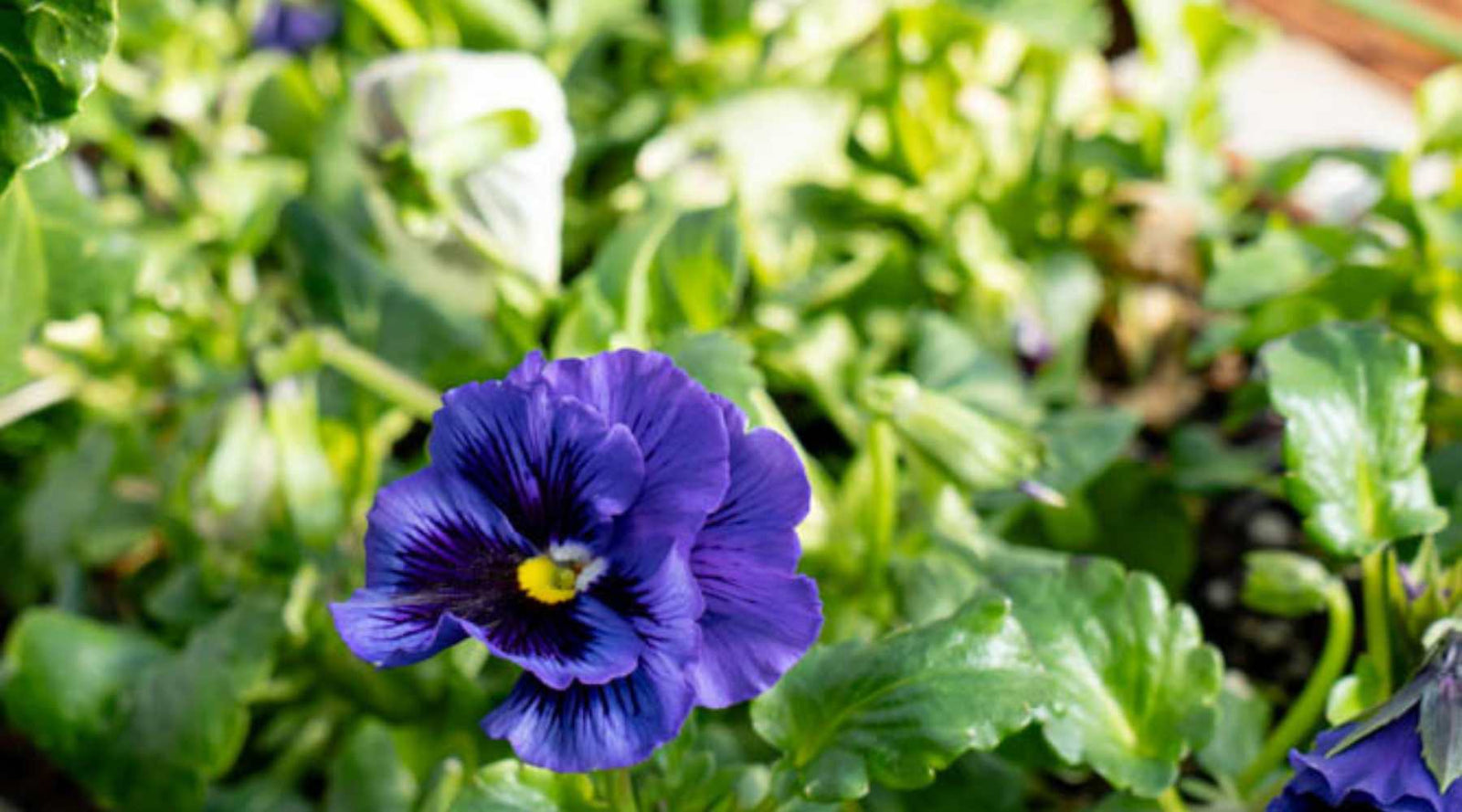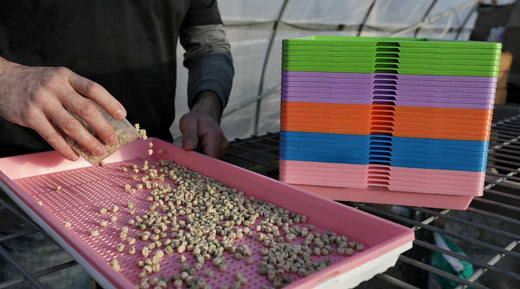Free Shipping on Orders over $75 to the Contiguous US
Free Shipping on Orders over $75 to the Contiguous US
Microgreens & Soaking Seeds - When & Why
February 24, 2023 6 min read 0 Comments

HOW TO SOAK MICROGREEN SEEDS
Soaking seeds for microgreens is a simple process that can dramatically increase germination rates and crop yields. At the most basic level it consists of rinsing the seeds, soaking them for 6-8 hours, rinsing again, and planting in prepared trays. Adding a sterilization step to the process can also help protect your crops and grow room from mold infestation. Knowing how long to soak your seeds for and how to adjust for your unique growing situation will help tremendously as you grow your crops and your business.

Do you really need to presoak microgreen seeds?
Many popular microgreen seeds benefit from soaking before planting. There are a few reasons why this is true and most of them are related to seed dormancy. The main purpose in soaking microgreen seeds is to jump start the germination process by overcoming dormancy.
There are a number of different types of dormancy that can affect germination time and rate. Dormancy can be internal or external, chemical, physiological or morphological. Seeds grown for microgreens like peas or sunflowers can be pulled out of dormancy by soaking. This has the dual benefit of softening the seed coat (physical dormancy) and diluting any inhibiting chemicals within the seed (chemical dormancy).
Temperature Effect on Germination
There are some types of dormancy that are affected by temperature in addition to the factors listed above. For the best germination rates it is helpful to ensure ideal ambient temperature for the seeds either by controlling the heat of the room or by using a seedling heat mat. Indoor grow rooms kept around 65℉-75℉ to prevent mold growth can be too cold for some seed types to germinate. This is when adding a heat mat can help to balance seed germination needs, mold growth prevention and growing plant needs.
For more tips on avoiding mold growth in your growing space be sure to check out this article in our microgreen growing guide on How to Combat Mold on Microgreens.
Seeds that need to be soaked
All of the larger microgreen seed varieties benefit from some presoaking. These include the following list as well as others of the same size. The amount of time each seed variety needs to soak is mostly dependent on the size of the seeds.
- Pea
- Sunflower
- Corn
- Garbanzo Bean
- Beet
- Swiss Chard
- Cilantro (whole seed)
- Nasturtium
- Mung Bean
- Fenugreek
- Buckwheat
Seeds that do not need to be soaked
Most of the smaller seeds used for microgreens do not need to be soaked prior to planting. While it may speed germination by a few hours it makes them far more difficult and time consuming to spread evenly. The seeds that do not need soaking are too numerous to list but the ones we get questions about most commonly here at Bootstrap Farmer are:
- Amaranth
- Broccoli
- Cabbage
- Cilantro (split seed)
- Kale
- Mustard Greens (See below for brown mustard)
- Radish

None of these need to be soaked before planting because placing them on moist growing media and misting throurly at planting time is generally enough to break dormancy for these smaller seeds.
Seeds you should never try to soak
Seeds that have a mucilaginous coating should never be soaked before planting because the coating will become extremely sticky. This causes the seeds to stick to one another and can cause mold issues, uneven germination and inconsistent growth. Mucilaginous seeds include the following.
- Arugula
- Basil
- Brown Mustard
- Chia
- Curly Cress
Steps and Tools for Proper Soaking Procedure
To get the most from your soaking time, having your tools on hand and clean before you start is helpful.
You will need the following tools in some version.
- Soaking vessel - This can be as simple as a large bowl, a 1020 tray or a dedicated food grade plastic container with a lid. It should be large enough to hold the volume of seeds you need to soak as well as at least three times that volume of water.
- Straining device - a colander or mesh 1020 tray. Plastic or non-reactive metal is best if you intend to sterilize using hydrogen peroxide.
- Plenty of clean running water.
- A sink or bucket
- Hydrogen peroxide (for sterilization)
Steps for Soaking Microgreen Seeds
- Premeasure seeds
- Rinse seeds
- Soak in clean, cold water
- Rinse seeds
- Sterilize for 5 minutes
- Rinse
- Plant in prepared trays or Presprout before planting in prepared trays

How long do microgreen seeds need to be soaked?
6-8 hours is the generally agreed upon length of time for soaking most seeds here at Bootstrap Farmer. We have seen recommended soaking times for things like peas and sunflowers as high as 24 hours. After running a number of our own experiments, we found that the increased hours beyond 8 did little to improve germination and made the seeds more susceptible to mold growth and to the seeds rotting before they could germinate.
Smaller seeds like buckwheat and beets can be soaked for as little as 4 hours with good results. This is one area where you will need to do some experimentation of your own. Different seed lots can be different sizes and different types of seeds may benefit from fewer or more hours. The ambient temperature and humidity of your grow room can also have an effect here.
Should you soak seeds overnight?
The short answer is no. Since for most seeds 6-8 hours is the maximum necessary time frame, soaking overnight can lead to mistakes. Seeds soaked overnight frequently end up getting soaked for far longer than intended. Excessive soaks can lead to bad germination rates and moldy seeds.
Sterilizing Microgreen Seeds Before Planting
The larger seeds are notorious for being “dirty.” This refers to the likelihood of the seed hull holding mold spores. For all of the larger seeds types, you can sterilize after you soak by submerging the seeds in a 3% hydrogen peroxide (h2o2) solution for 5 minutes before planting. Be sure to remove the h2o2 after 5 minutes and rinse the seeds fully one more time before planting or sprouting.
For smaller seeds you can help deter mold growth by using the same 3% h2o2 solution to mist the seeds after planting. Be sure to mist again with pure water after 5 minutes.
If the peroxide is left on the seed too long the chemical reaction can cause the seeds to heat up and air pockets to form between the seed and its hull.
Mixing your own hydrogen peroxide
A concentration of 3% h2o2 is ideal for sterilizing seeds and grow room equipment. Store bought 3% hydrogen peroxide from a pharmacy is often treated with stabilizers to extend its shelf life. Since it is not a food product companies are not required to tell you what these stabilizers are.
We recommend using a food grade 3% h2o2 solution for your sterilizing solution. It is far more economical to purchase the more concentrated 34% solution and dilute it down yourself just before using. The 34% solution can be found in many hydroponic and aquarium supply stores and is often labeled as an oxygenator.
Use extreme caution during the mixing process and wear protective equipment; long sleeves, gloves and safety glasses. 34% h2o2 is an acid and will burn skin as well as bleach fabrics. Mixing it at a ratio of 10 parts water to one part concentrate creates a milder solution that is far less dangerous but can still cause bleaching and skin irritation.
Try not to mix more than you plan to use in a week at one time. Store in a sealed container to avoid spills.
Pre-Sprouting Before Planting
Some growers maintain that pre-sprouting seeds in a container before placing them on the soil or growing media is a quicker way to start. This can be done in the same container you used to strain your seeds after soaking. We like to use a shallow or deep mesh 1020 tray for this purpose as it allows you to easily spread out the seeds and quickly rinse them.
Sprouting seeds in a tray or colander only takes about 12-24 hours after soaking. You will need to rinse the seeds to keep them moist during this process. Depending on the ambient humidity of your room this may be every few hours or just once during the day. The important part here is to make sure the seed does not dry out once the germination process begins.
Once the radicle begins to emerge, plant the seeds in your prepared trays. A radicle is the term used to describe the part of the plant embryo that develops into the growing tip of the root. Plant as soon as you can after the radicle emerges to avoid the roots needing to change direction after they are planted. The geotropism which is the force of gravity acting on the plant, will cause the roots to turn downward as soon as they emerge from the seed covering.

Troubleshooting problems with microgreen seeds and germination
Check out 6 Common Microgreen Problems and How to Solve Them for more tips on early germination of microgreen trays. You can also browse our various microgreen articles to find how-to's on growing microgreens.
Also in Microgreens Guides & Resources

How to Market Microgreens: Strategies That Get Results
March 27, 2025 13 min read 0 Comments
In this article, we’ll help you stay at the top of your microgreen game to help you succeed in this exciting venture.

Must-Know Tips for Edible Flower Farming Success
October 20, 2025 9 min read 0 Comments
Learn how to expand your markets, what popular edible flowers to offer, marketing tips, new trends, and best practices.

What Lights Do I Need to Grow Microgreens?
January 13, 2025 10 min read 0 Comments
Recent Articles
- How to Market Microgreens: Strategies That Get Results
- Must-Know Tips for Edible Flower Farming Success
- What Lights Do I Need to Grow Microgreens?
- How To Grow Microgreens Indoors - SEED to HARVEST
- A Quick Guide to Starting a Microgreens Business
- How and When to Use 10x10 Microgreen Trays to Grow Nutrient-Packed Greens
- How to Disinfect Seeds Before Planting and Sprouting
- Top 5 Best Growing Mediums for Microgreens
- What Trays Do You Need for Microgreens and Propagation?
- Top Ten Microgreens to Grow
Subscribe
Sign up to get the latest on sales, new releases and more …
